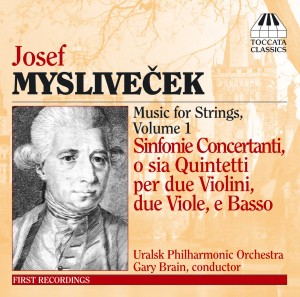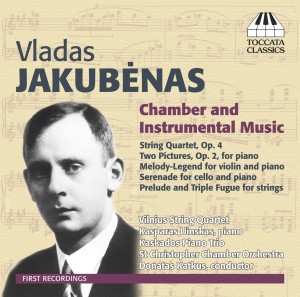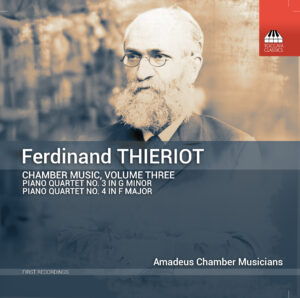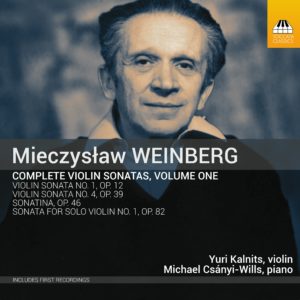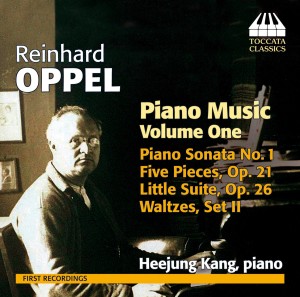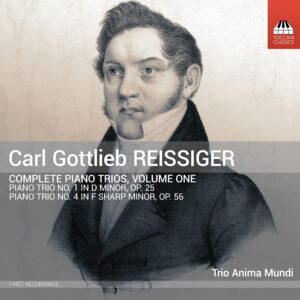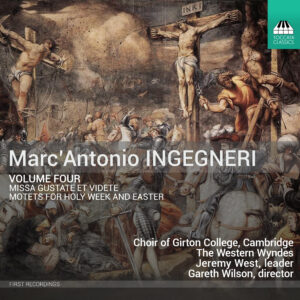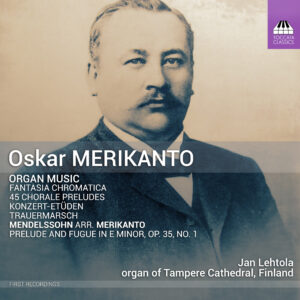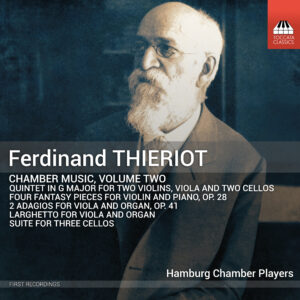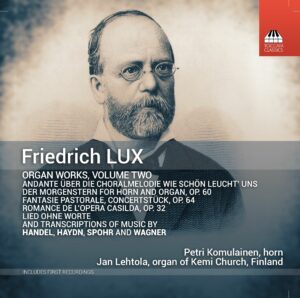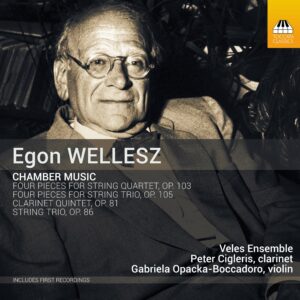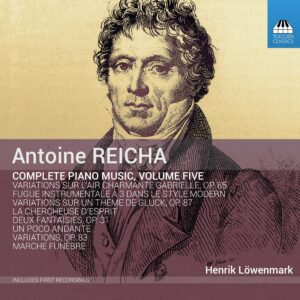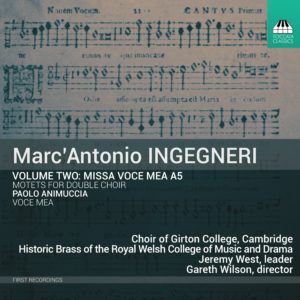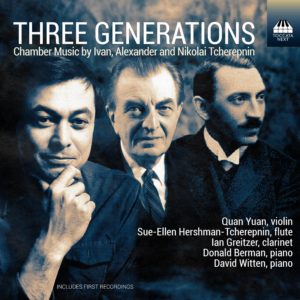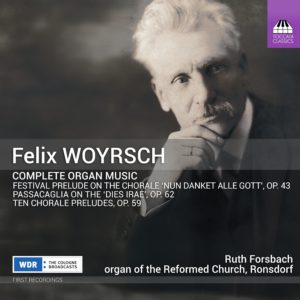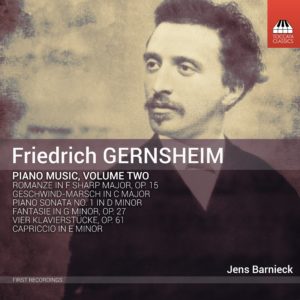Search Results for "obras de william makepeace thackeray" – Page 8
Showing results for operas william magpies teacher
Josef Mysliveček: Music for Strings, Volume One
Josef Mysliveček (1737–81) – born in Prague, based in Italy – was one of the chief architects of the 'high’ Classical style that emerged in Europe around 1770, and one of the most important musical influences on the young Mozart. The works on this CD, composed in the mid-1760s, were published to be performed as string symphonies, as here, or as quintets for two violins, two violas and cello, the earliest such works ever to appear in print. Their grace, passion and tenderness help explain why Mozart so admired Mysliveček’s operas and instrumental music.
Uralsk Philharmonic Orchestra, orchestra
Gary Brain, conductor
Vladas Jakubėnas: Chamber and Instrumental Music
As composer, critic, teacher and musical activist, Vladas Jakubėnas (1904–76) was one of the major cultural figures in pre-World War Two Lithuania, before his post-War exile in the USA. As a student of Schreker in Berlin in 1928–32, he initially wrote in a Neoclassical style – as most of the works on this CD attest – and was nicknamed 'the Lithuanian Hindemith’. Back home, he began to compose in a late-Romantic, gently modernist idiom, tinged with the influence of Lithuanian folk-music.
Vilnius String Quartet, string quartet
Kasparas Uinskas, piano
Rusnė Mataitytė, violin
Edmundas Kulikauskas, cello
Albina Šikšniūtė, piano
St Christopher Chamber Orchestra, chamber orchestra
Donatas Katkus, conductor
Ferdinand Thieriot: Chamber Music, Volume Three
The Hamburg-born Ferdinand Thieriot (1838–1919) not only shared a teacher – Eduard Marxsen – with Brahms; both composers use a very similar musical language, one which is richly melodic and effortlessly contrapuntal. The musicologist Wilhelm Altmann wrote that ‘Thieriot’s chamber music is without exception noble and pure. He writes with perfect command of form and expression’ – as the works on this third Toccata Classics volume prove, in their exquisite balance of depth and beauty.
Amadeus Chamber Musicians
Dmitriy Daniel Askerov, violin
Jenny Joelson, viola
Luzi Dubs, cello
Rebecca Ineichen, piano
Mieczysław Weinberg: Complete Violin Sonatas, Volume One
Mieczysław Weinberg, born in Warsaw in 1919, became a close friend of Shostakovich in Moscow, after fleeing eastwards before the invading Nazis in 1939. His vast output includes 26 symphonies, seven operas, seventeen string quartets and much other chamber music and some 200 songs. His style has much in common with Shostakovich, as these four violin works show: fluent contrapuntal skill, a keen feeling for melody, often inflected with Jewish cantilena, and an acute sense of drama which combines a natural narrative manner with an extraordinary ability to create atmosphere, often from just a handful of notes. Since his death in 1996, his music is being discovered by musicians and listeners all around the world.
Yuri Kalnits, violin
Michael Csányi-Wills, piano
Reinhard Oppel: Piano Music, Volume One
Reinhard Oppel (1878–1941) was a major figure in inter-War Germany, as composer, teacher and theoretician. His rich, late-Romantic music encompasses symphonies, chamber and choral music, songs and works for piano. His music went underground in East Germany – literally: after World War II, when his family fled west from the occupying Russian army, they hid his music under the garden shed and there it remained, unknown, until the fall of Communism, when his son was able to return and retrieve it. This first CD of his heart-warming, Dvořákian piano music begins a series of releases intended to win Oppel’s music the audience it deserves.
Heejung Kang, piano
Carl Gottlieb Reissiger: Complete Piano Trios, Volume One
In his day the now-forgotten Carl Gottlieb Reissiger (1798–1859) was highly esteemed, both as conductor and composer; indeed, his presence in Dresden from 1826 made it one of the main operatic centres in Germany. He wrote nine operas himself, as well as a huge quantity of vocal music (including at least twelve Masses), and his large output of chamber music boasts no fewer than 27 piano trios. These two early exemplars in this first-ever complete recorded cycle of those trios have a Mendelssohnian elegance and clarity, deepened here and there by a touch of Beethovenian pathos. Schumann was an enthusiast: ‘When I think of Reissiger’s trios, the words lovely and jewel-like come to mind. These choice and lovely works remind one of a chain of flowers. […] His music never fatigues the ear, but holds our attention to the very end’.
Trio Anima Mundi
Marc’Antonio Ingegneri: Volume Four – Missa Gustate et videte; Motets for Holy Week and Easter
The Cremonese composer Marc’Antonio Ingegneri (c. 1535/36–92) is chiefly remembered as the teacher of Claudio Monteverdi while, for well-nigh 500 years, his own achievements were left to sit in the shadows. This fourth in a series of pioneering recordings from the Choir of Girton College, Cambridge, presents a sequence of music for Holy Week and Easter, confirming Ingegneri to have been one of the masters of his age. The striking range of moods heard here will confound conventional expectations of Renaissance polyphony: Ingegneri’s emotional palette extends from tender intimacy in some of these motets to dancing, celebratory jubilation in the Mass setting – all of it music of breathtaking richness and beauty.
Choir of Girton College, Cambridge
The Western Wyndes
Jeremy West, leader
Gareth Wilson, director
Oskar Merikanto: Organ Music
Oskar Merikanto (1868–1924) made an enormous contribution to music-making in Finland, and to organ music in particular, as teacher, virtuoso performer and authority on performance practice, reforming the approach to the organ in both church and concert- hall. It was thought that all of his organ music was known and recorded, but recent discoveries have added a number of previously unsuspected works to his catalogue: a striking concert fantasia, an early funeral march, some pedal studies, a vast series of chorale preludes – some of them beautifully crafted miniatures, others only aphoristic ideas – and an organ transcription of a piano piece by Mendelssohn. This release is timed to mark the centenary of his death, on 17 February 1924.
Jan Lehtola, organ of Tampere Cathedral, Finland
Ferdinand Thieriot: Chamber Music, Volume Two
The Hamburg-born Ferdinand Thieriot (1838–1919) not only shared a teacher – Eduard Marxsen – with Brahms; both composers use a very similar musical language, one which is richly melodic and effortlessly contrapuntal. The musicologist Wilhelm Altmann wrote that ‘Thieriot’s chamber music is without exception noble and pure. He writes with perfect command of form and expression’ – as the works on this second Toccata Classics volume prove, in their exquisite balance of depth and beauty.
Hamburg Chamber Players
Ian Mardon, violin
Matthias Brommann, violin
Julia Mensching, viola
Olga Dowbusch-Lubotsky, cello
Suren Anisonyan, cello
Clovis Michon, cello
Andrea Merlo, piano
Alexander Bürkle, organ
Friedrich Lux: Organ Works, Volume Two
Friedrich Lux (1820–95) was one of those musicians who formed the fabric of musical life in nineteenth-century Germany: though he worked away from the major cities, as conductor, teacher, organist, organiser and composer, he was an indispensable element of the communities in which he worked. His large body of organ music, as good as unknown before now, brings together elements of the musical language of Bach, Mendelssohn and Schumann, in works that range from the intimate to the grandiose.This second volume brings some of his many transcriptions to the fore.
Petri Komulainen, horn
Jan Lehtola, organ of Kemi Church, Finland
Egon Wellesz: Chamber Music
In its mix of tonality, Expressionism and Schoenbergian serialism, the late chamber music of Egon Wellesz (1885–1974) – born in Vienna but an Oxford don for almost four decades – marries the mid-century radicalism of his native city with the lyricism of his adoptive homeland. In the first part of his career Wellesz was best known as a composer of operas, and these chamber works were audibly written by someone with a keen sense of drama: in their primal passion, flawless pacing, arching melodic lines and occasional bursts of humour, one can almost imagine them on stage.
Veles Ensemble
Hartmut Richter, violin
Ralitsa Naydenova, viola
Evva Mizerska, cello
Gabriela Opacka-Boccadoro, violin (Tracks 9-15)
Peter Cigleris, clarinet (Tracks 13-15)
Antoine Reicha: Complete Piano Music, Volume Five
The piano music of the Czech-born composer Antoine Reicha (1770–1836) – friend of Haydn and Beethoven, teacher of Berlioz, Liszt and Franck – has only recently begun to be discovered. He was an important influence on composers of the next generation but until recent years his piano works remained almost completely unknown. Encompassing Baroque practices, as well as looking forward to the twentieth century, they are full of harmonic and other surprises that show this liveliest of musical minds at work. In this fifth volume of his survey of Reicha’s piano music Henrik Löwenmark demonstrates the breadth of Reicha’s quixotic imagination, with three variation sets and a number of smaller character pieces.
Henrik Löwenmark piano
Marc’Antonio Ingegneri: Volume Two: Missa Voce Mea A5, Motets for double choir
The Cremonese composer Marc’Antonio Ingegneri (c. 1535/36–92) is chiefly remembered as the teacher of Claudio Monteverdi, while, for well-nigh 500 years, his own achievements were left to sit in the shadows. This second in a series of pioneering recordings from the Choir of Girton College, Cambridge, reveals Ingegneri to have been one of the masters of his age, writing music of breathtaking richness and beauty: the works heard here combine learned, intricate counterpoint with the kind of sheer sonic thrill that brings a shiver of physical excitement. It is, of course, religious music, but it is also extraordinarily passionate, to a degree not previously heard, nor for centuries to come, until the rise of the great Romantic choral works.
Choir of Girton College, Cambridge (Tracks 1–3, 5–8, 10, 12–14)
Historic Brass of the Royal Welsh College of Music and Drama (Tracks 1, 3–14)
Jeremy West, leader
Gareth Wilson, director
Three Generations
This album explores music by three father-and-son generations of the Tcherepnin family of composers: Nikolai, Alexander and Ivan. Although each wrote a wide range of scores, from solo pieces to operas and ballets, this recording focuses on their chamber music, presenting pieces spanning 95 years. Nikolai’s works for violin and piano reveal a late-Romantic, post-Tchaikovskian sensibility, whereas those of Alexander have a more modern, twentieth-century touch, closer to the style of his friend Sergei Prokofiev (a student of Nikolai Tcherepnin). Ivan is represented by two works — early and late – for flute, clarinet and piano, which have an improvisatory and playful quality.
Quan Yuan, violin (Tracks 1–9)
Sue-Ellen Hershman-Tcherepnin, flute (Tracks 10, 11)
Ian Greitzer, clarinet (Track 11)
David Witten, piano (Tracks 1–10)
Donald Berman, piano (Track 11)
Felix Woyrsch: Complete Organ Music
The German composer Felix Woyrsch was born in 1860 in Troppau (then the capital of Austrian Silesia and now, as Opava, in the Czech Republic) but became prominent in the musical life of Altona, now part of Hamburg, as organist, choirmaster and teacher; he died there in 1944. Woyrsch’s late-Romantic organ music, with distant roots in Bach’s counterpoint, inhabits a harmonic world somewhere between Brahms and Reger, its dark colours reflecting the upheavals in the times through which he lived.
Ruth Forsbach, organ of the Reformed Church, Ronsdorf
Friedrich Gernsheim: Piano Music Volume Two
Friedrich Gernsheim (1839–1916), born in Worms, on the Rhine, grew up to be one of the most formidable musicians of his age: composer, pianist, conductor and teacher. Even as a teenager, Gernsheim was attracting attention as a virtuoso-composer, earning comparisons with Mozart. The works here document the emergence of his own musical personality, from an early sonata, which has a Mozartian opening and a Beethovenian slow movement, via a dalliance with Schumann, until he reaches a mature style comparable to Brahms in its emotional range and depth.
Jens Barnieck, piano
Stay In the Know
JOIN THE TOCCATA NEWSLETTER
"*" indicates required fields
By visiting our site, you agree to our privacy policy regarding cookies, tracking statistics, etc.
